Lectures/Classes 2014
February 7, 2014 by admin
Filed under Garden Lectures
Wednesday, February 12
When: 9:30 am
Where: John Jay Homestead, 400 Jay St., Katonah, NY
Monthly meeting of the Bedford (NY) Garden Club
Lecture: Shade Revealed: How to Garden Successfully in Low Light (Really!)
Thank you to the Bedford Garden Club for hosting this event.
Thursday, February 13 (snow date February 20)
When: 1:15 pm
Where: St. Luke’s Church, 49 Turkey Hill Rd. North, Westport, CT
Monthly meeting of the Westport (CT) Garden Club
Lecture: Shade Revealed: How to Garden Successfully in Low Light (Really!)
Thank you to the Westport Garden Club for hosting this event.
Monday, March 10
When: 1:00 pm
Where: private home, New Canaan, CT
Monthly meeting of the New Canaan (CT) Gardeners
Lecture: Shade Revealed: How to Garden Successfully in Low Light (Really!)
Thank you to the New Canaan Gardeners for hosting this event.
Friday, March 21
When: 1:45 pm
Where: Lewis B. Rome Commons, University of Connecticut campus, 626 Gilbert Rd. Extension, Storrs, CT
UConn 2014 Garden Conference
Registration required; fee charged; visit the event registration web page for more information
Lecture: Shade Revealed: How to Garden Successfully in Low Light (Really!)
Thank you to the UConn College of Agriculture and Natural Resources Extension, the Ornamental Plant Extension Team, and the Home and Garden Education Center for organizing this event.
Wednesday, April 9 (snow date April 10)
When: 5:00 pm social; 6:00 pm lecture
Where: St. Mary’s Auditorium, 43 Foreside Rd., Falmouth, ME
Great Gardener Series fundraiser for St. Mary’s Garden Club
Tickets: $16 in advance; $20 at the door; visit the event web page for directions and more information
Lecture: Cottage Gardening: Adapting a Classic Garden Style to the Northeast
Thank you to the St. Mary’s Garden Club for hosting this event.
Saturday, April 12
When: 10:00 am
Where: White Flower Farm, 167 Litchfield Rd. (Rte. 63), Morris, CT
Registration fee: $15; advance registration requested. See the event registration web page for details
Lecture: Shade Revealed: How to Garden Successfully in Low Light (Really!)
Thank you to White Flower Farm for hosting this event.
Wednesday, May 14
When: 10:00 am
Where: Waveny House, 677 South Ave., New Canaan, CT
Monthly meeting of the New Canaan Garden Club
Lecture: Containers that Won’t Quit
Thank you to the New Canaan Garden Club for hosting this event.
Plants for Shade Containers
May 28, 2012 by admin
Filed under Container Gardening, Shade Gardening
A year ago I blogged about the subject of my Containers that Won’t Quit lecture, which is how to compose containers that will look as good in September as they do in June. That prompted a request for a post recommending great shade tolerant plants for containers. In my area, Memorial Day weekend is when it’s considered “safe” (reliably free from frost) to plant annuals and tender perennials, so it’s often when people plant their containers. In light of that, here are some recommendations—annual and otherwise—for your shade containers.
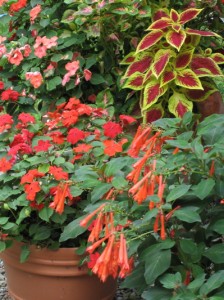
Color-coordinated fuchsia, gold-margined coleus and impatiens in containers
Your options for attractive compositions will expand considerably if you’re willing to use plenty of colorful foliage and not restrict yourself to flowering plants. Interestingly, many of the best plants for this purpose are things you might already know as houseplants or hardy perennials.
Second, a rule of thumb: In shade, gold rules. That is, no color shows up in the shadows better than gold—not even white. Creeping Jenny (Lysimachia nummularia ‘Aurea’) is a fast-growing plant whose long stems bearing bright, penny-shaped leaves will trail beautifully over the sides of containers. It’s sold as an annual in garden centers in spring, but it’s actually a perennial supposedly hardy to USDA Zone 3, and I can say for sure it’s hardy here in Zone 5. I’d also try cultivars of the perennial grass Hakonechloa macra, which has a lax, compact and clumping habit. ‘Aureola’ and ‘All Gold’ are two choices that will give you a bright splash of virtual sunshine to light up shady spaces.
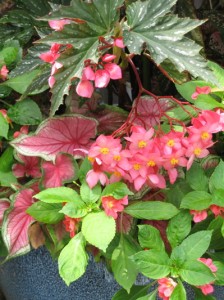
Fancy begonia, caladium and Fusion impatiens make a shade portrait in pink
Five wonderful houseplants for container use are asparagus fern (Asparagus densiflorus, usually ‘Sprengeri’), Southern maidenhair fern (Adiantum capillus-veneris), polka-dot plant (Hypoestes), peace lily (Spathiphyllum) and Schefflera. The first two will add a feathery, delicate texture to your container combinations, while I often use the last two as solitary specimens filling an entire container on their own.
Peace lily is one of the very best performng plants for very low light situations because it has attractive, glossy, lance-shaped leaves in profusion and it produces showy white flowers continuously. Schefflera comes in a gold-variegated form made all the more attractive by the fact that no two leaves have the same coloration. As an added benefit, both can be overwintered easily in a bright spot indoors and then returned to outdoor containers year after year. The lovely Southern maidenhair fern, in contrast, needs such high humidity during the winter months that I simply discard it in fall and buy new in spring.
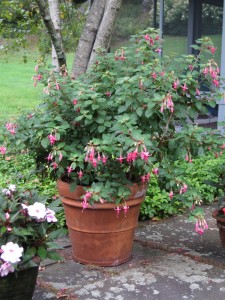
Three Fuchsia 'Mrs. J.D. Fredericks' fill a pot beautifully on their own
In light shade, and still considering foliage plants, try tropicals such as Alocasia and Colocasia. Depending on the selection, both have the potential to get quite large, so generally speaking these will be choices for larger containers. They’ll give you a lushness that will stand out in a northern landscape.
For a similarly tropical look but a naturally more compact habit, you can’t beat Caladium and Syngonium. Few people seem to know the latter plant, which is a caladium lookalike, but it’s usually sold as a houseplant. The most common form has mottled, apple green leaves with a fresh appearance. Caladiums can range from the fairly subtle to the almost garish. ‘Candidum’ types have a tasteful, green-and-white simplicity, while others are heavily splashed with bright red and pink. (Click here to see a number of containers featuring several of the tropicals mentioned above.)
And of course I can’t neglect to mention coleus (Solenostemon). In the north, most coleus actually need brighter conditions than their reputation suggests, but they’re great plants for spots with morning sun or bright but indirect light. Some of my favorites are ‘Kingswood Torch’, ‘Festive Dance’ and ‘Butter Cream’.
The selection of flowering plants that will bloom all summer in northern shade is slim. For lighter shade, you can get away with fuchsias (I recommend two upright types: orange ‘Gartenmeister Bonstedt’ and pink ‘Mrs. J.D. Fredericks’—see above) and trailing wishbone flower (Torenia). The Summer Wave series of torenias will produce a waterfall of flowers in shades of purple, blue, rose and even pale yellow.
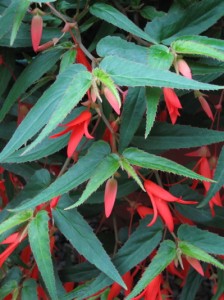
Begonia boliviensis 'Bonfire' trails to produce cascades of brilliant flowers
I mentioned that many perennials also make great container plants, with the added benefit of being able to overwinter them in the ground outdoors and then replant them in your containers in spring. You might even find that they overwinter in your containers just fine, eliminating that extra step.
Virtually any hardy fern that’s the right size and shape for your container would be an excellent choice for shade. Hostas, too, are a good choice no matter the size of your container because there are hostas ranging from miniatures to monsters.
The drapey dead nettles (Lamium) such as ‘White Nancy’ will provide both flowers on and off throughout the summer and good frosty foliage.
Finally, many selections of the perennial Heuchera (coral bells) have been introduced in the past few years with mouthwateringly beautiful foliage. Tantalizingly, selections in the Dolce series are all named after foods! ‘Key Lime Pie’, ‘Peach Melba’ and ‘Blackcurrant’ will spice up your shade containers with colors to rival those of any flowers.
Containers that Won’t Quit
January 22, 2011 by admin
Filed under Container Gardening
All too often, advice about container gardening seems to come in the form of some kind of “design challenge” in which container gardens are judged based on a photograph taken at a single point in time. This sort of thing has its place, but most of us aren’t planting containers to enter in the equivalent of a flower show exhibit. We’re planting them with the intention of beautifying some space for the entire growing season. Here in the North, that means June, July, August and hopefully beyond. That’s a different sort of challenge altogether.
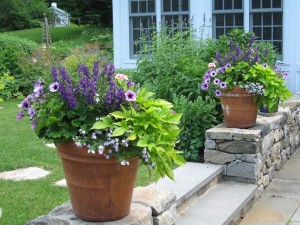
A classic container combination looking fresh in June...
What’s more, it seems like too many of the “design challenge” winners feature things like Hardtofindium breakthebankium as a centerpiece. That’s my name for a plant that was discovered growing on a scree slope in the Himalayas just last year and can only be procured at midnight during a lunar eclipse at a remote location from a shady character who requires a ransom payment and a secret code word. (Didn’t think horticulture was so Hollywood, did you?)
Okay, I’m exaggerating a little bit, but really—how many of us have the time and money to track down obscure plants from specialty growers? I’m not disparaging either one (plants or growers), but the majority of gardeners just don’t garden that way. They put together their containers using what they find at the nearest good nursery.
It’s because of the shortcomings of the “design challenge” sort of articles and TV segments that have become so widespread that I recently created a new talk entitled “Containers that Won’t Quit.”* It’s all about how to plant containers that will look as good in September as they do in June using common, easy to procure materials. Take a look at the pair of photographs above left and below right, and you’ll see what I mean.
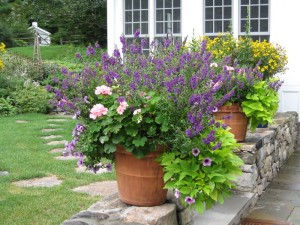
...and just as beautiful in September!
For a container to look good all season long, its flowers can’t peter out in the heat of summer, and there has to be an easy way to keep its components in proportion as they grow. It goes without saying that the plants in the container have to remain healthy, so I place a premium on plants that are naturally disease resistant.
These requirements all lead to a particular approach to container gardening based on using a “short list” of the best plants, learning how to imagine at planting time how the container will look when it’s developed, following a few basic design tips, and performing some easy, routine maintenance to keep everything at its best.
The containers in the photos above were planted for a client who once told me, “This will sound kind of boring, but I really just like petunias and geraniums.” So I planted the exceptional purple Supertunia ‘Bordeaux’ (one of the top two or three petunias you can buy, in my opinion) with pink geraniums, blue Bacopa, ‘Sweet Caroline’ sweet potato vine (Ipomoea), and a purple angelonia. The combination is simple, inexpensive, classic, and absolutely stunning all summer long. The only care it requires (above and beyond the obvious watering and fertilizing) is deadheading the geraniums weekly, cutting the petunias and the sweet potato vine back two or three times during the summer, and occasionally clipping out spent angelonia stems to encourage branching. That’s about as easy as a container gets.
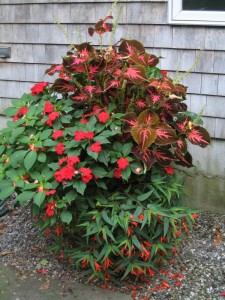
A long-lasting hot color combo for moderate shade
Consider the container pictured at left. It’s one of my favorites from the past few years. What’s in it? Certainly nothing exotic: coleus, impatiens and begonia. That’s it! What makes it work so well is using superior selections of these common plants. The coleus at the rear is ‘Kingswood Torch’, which grows into an impressive plant with just a couple hours of sunlight each day, as well as the Fusion series impatiens (‘Infrared’, in this case) interplanted with the old-fashioned, been-around-forever red Super Elfin Impatiens x walleriana from 6-packs, and ‘Bonfire’, a type of Begonia boliviensis that has made its way into the trade in the last few years. This begonia is quite disease resistant, has a graceful trailing habit, and (as you can see) is super-floriferous.
Want to keep things even simpler? You can’t get any easier than a container with just one kind of plant. In sun, my first choice would be Calibrachoa (sometimes called by the common name “million bells”). These petunia relatives, with flowers that look like miniature versions of their cousins, are possibly the single best trailing flowering plants around. For hanging baskets, they’re unsurpassed. Combine a couple of them in complementary colors, and you’ve got a smashing container. Or, add a simple companion like Euphorbia ‘Diamond Frost’ (shown below with Calibrachoa ‘Crackling Fire’) for a little contrast.
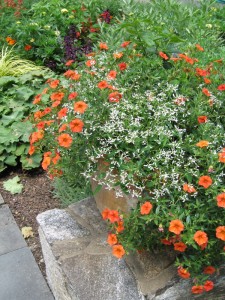
A super simple container that stands up to heat
In shade, one of the very best plants capable of filling a container on its own and flowering all season long is Spathiphyllum, often called “peace lily.” You’ll usually find it in the greenhouse at your local nursery because it’s grown as a houseplant. You’ll pay $25-30 for a good-sized specimen, but it’s a plant you’ll be able to overwinter easily (it’s just dirt simple to care for) and return to your shade containers outside year after year after year, so it’s a great long-term investment.
I’ll be writing more about designing containers in future blog posts, but I’ll mention one important concept now: echoing color and shape. Of course, you’re free to plant a container that’s an absolute circus of colors and shapes if that’s what you want. But most people seem to agree that having some kind of relationship between the plants in a container is most satisfying to the eye. Two or more plants that feature similar colors or shapes in either their flowers or leaves harmonize, whereas totally dissimilar plants are much less likely to make an appealing combination. One caveat, though: you don’t want the plants to be too similar or the effect won’t be nearly as attractive.
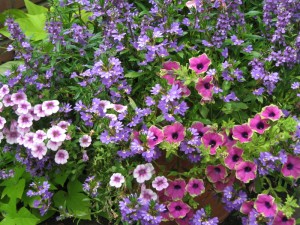
Echoing flower colors and shapes
The combination of Calibrachoa Superbells ‘Tickled Pink’ and Petunia Supertunia ‘Pretty Much Picasso’ (along with purple Scaevola) shown at left illustrates both ideas. The flowers of both plants have a flared bell shape, while the light pink of one blends beautifully with the hot pink of the other even as the two remain distinct. Additionally, the chartreuse margin of the petunia flowers picks up the bright green leaves of ‘Sweet Caroline’ sweet potato vine at far left.
If you haven’t always been happy with your container gardens, consider my Containers that Won’t Quit approach. I’ll be writing more about it down the line, so don’t forget to subscribe. And if you’d like to have me give the full story about Containers that Won’t Quit to your garden club or other group, please drop me a line using this Contact form to let me know of your interest. Until then, may your winter be restful and restorative and a time to learn new ideas for the coming gardening season!
Have you got a photograph of your own favorite Container that Won’t Quit combination? Be sure to label everything as fully as you can and describe why you like it so much. Then send it along and I’ll post it for other readers to see.
* I just had the pleasure of debuting Containers that Won’t Quit for the Taconic Gardeners Club in Chappaqua, NY, and I’d like to thank the club for the opportunity. Before and after the talk I enjoyed chatting with several members about plants, containers, garden photography and more, and I can say that they’re a great group. If you’re located in the lower Hudson Valley, southwest Connecticut or even New York City, they’d love to have you as a member and I know you’d enjoy knowing them. Please take a look at their website and consider joining.

